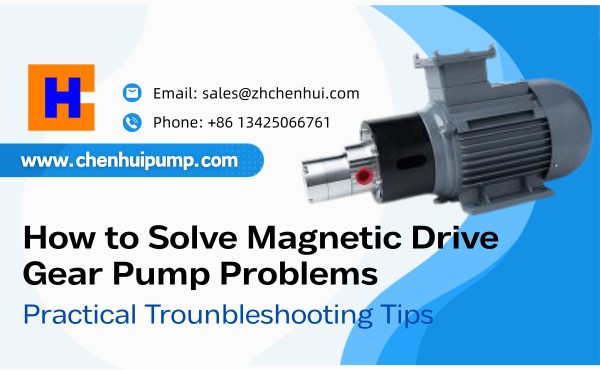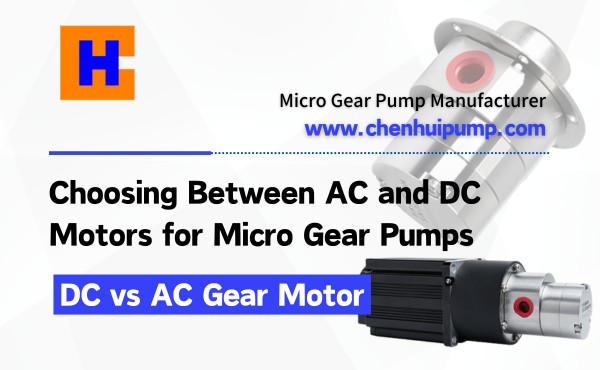Gear pumps are one of the most used industrial fluid transfer tools. However, they have some advantages and disadvantages.
The advantages of a gear pump include its simple, compact, and durable design, consistent and efficient fluid transfer, and applicability to a wide range of tasks. While the disadvantages of gear pumps include pulsating flow, limitations with abrasive fluids and solids, and operational noise. Besides, they cannot handle solids or abrasive materials, which limits their applications.
In this article, we will explore the benefits and drawbacks of gear pumps, commonly found in hydraulic power units and viscous fluid transfer systems.
What is a Gear Pump and its Working Principle
A gear pump is a positive displacement pump that moves fluids by trapping them between rotating gears. It creates a vacuum at the pump inlet, which draws fluid into the gear chamber. As the gears rotate, they transfer the fluid along the outer edges of the chamber to the outlet, ensuring a steady and consistent flow of liquid.
The pump’s design typically includes two gears: a driving gear and a driven gear. These gears mesh together, forming tight clearances that prevent fluid from flowing backward. This mechanism makes these pumps highly efficient for transferring liquids, especially those with high viscosity.
Key Features of Gear Pumps
Gear pumps offer several distinct features that make them a popular choice in various industries:
Compact Design: Their small size allows for easy installation in tight spaces.
Self-Priming Capability: It can start pumping without needing to be filled with fluid beforehand.
Bidirectional Operation: These pumps can move fluids in both directions, adding versatility.
High Efficiency: The tight clearances between gears minimize fluid leakage, ensuring efficient operation.
Gear Pump Advantages
High Efficiency and Energy Savings
One of the most notable advantages of gear pumps, including both internal gear and external gear types, is their high efficiency. These pumps operate with minimal fluid leakage due to the tight clearances between the gears. This design ensures energy is not wasted, making them an energy-efficient choice for many industries. By maintaining consistent pressure and flow, they reduce the need for additional energy input, which can lower operational costs over time.
Their efficiency also extends to handling high-viscosity fluids. Unlike other pump types, gear pumps maintain performance even when dealing with thick liquids, ensuring smooth operation without excessive energy consumption.
Smooth and Consistent Fluid Flow
Gear pumps excel at delivering a steady and uninterrupted flow of fluid, making them a preferred type of pump for many applications. This is one of the key advantages that makes them ideal for applications requiring precision, such as chemical dosing or lubrication systems. The meshing gears create a uniform flow, eliminating pulsations that can occur with other pump types.
Industries that rely on consistent fluid delivery, such as food processing or hydraulic systems, benefit significantly from this feature. The smooth operation of gear pumps, especially types of those designed for high efficiency, ensures that processes run efficiently without interruptions caused by uneven fluid flow.
Compact and Space-Saving Design
Another essential advantage of gear pumps is their compact design. These small and lightweight pumps make them easy to install in systems with limited space. Their size does not compromise their performance, as they still deliver high efficiency and reliable operation.
The compact nature of gear pumps makes them a preferred choice for industries where space is a constraint. For example, they are often used in mobile hydraulic systems or small-scale industrial setups. Their ability to fit into tight spaces without sacrificing functionality adds to their appeal.
Ability to Handle High-Viscosity Fluids
Gear pumps excel at handling high-viscosity fluids, making them a preferred choice for industries dealing with thick liquids. Their positive displacement mechanism ensures that even the most viscous substances, such as oils, syrups, and adhesives, can be transferred efficiently. Unlike centrifugal pumps, which struggle with thick fluids, gear pumps, including the internal gear type, maintain consistent performance without requiring additional modifications.
The design of gear pumps plays a significant role in their ability to manage high-viscosity fluids. The tight clearances between the gears create a strong seal, preventing fluid leakage and ensuring smooth operation. This feature allows the pump to maintain steady pressure and flow, even when dealing with challenging substances.
This capability benefits industries such as food processing, chemical manufacturing, and lubrication systems greatly. These pumps provide reliable and precise fluid transfer, essential for maintaining product quality and process efficiency.
Low Maintenance Requirements
Gear pumps are known for their low maintenance needs, which makes them a cost-effective option for many applications. Their simple design, with fewer moving parts, reduces the likelihood of mechanical failure. This simplicity makes routine inspections and repairs straightforward, saving time and resources.
The robust construction of gear pumps minimizes wear and tear, primarily when used with non-abrasive fluids. Regular maintenance typically involves checking for proper lubrication, inspecting seals, and ensuring the gears remain in good condition. These tasks are easy to perform and do not require specialized tools or expertise.
Durability and Long Service Life
Durability is one of the standout features of gear pumps. Their sturdy construction and high-quality materials enable them to withstand demanding operating conditions. Whether exposed to high pressures, extreme temperatures, or continuous use, gear pumps maintain their performance over time.
Gear pumps’ long service life reduces the need for frequent replacements, making them a reliable investment for industries. Their ability to handle a wide range of fluids without significant wear further enhances their durability. Proper maintenance and using compatible fluids can extend their lifespan even further.
Self-Priming and Bidirectional Functionality
Both the eternal and internal gear pumps offer two significant features that enhance their versatility: self-priming and bidirectional functionality. These attributes make them a practical choice for various industrial applications.
Self-Priming Capability
Gear pumps can prime themselves without requiring external assistance. This means they can start pumping fluids even when the suction line is not filled. The tight clearances between the gears create a vacuum, drawing fluid into the pump chamber. This feature eliminates the need for pre-filling or additional priming equipment, saving time and effort during operation.
The self-priming ability also ensures reliable performance when the pump may temporarily lose Its prime, such as during intermittent operation, is a critical aspect of the internal gear pump’s functionality. This makes gear pumps a dependable option for tasks requiring consistent fluid transfer.
Bidirectional Functionality
Another advantage of gear pumps is their ability to operate in both directions. By reversing the rotation of the driving gear, the pump can change the direction of fluid flow, a feature common to both internal gear and external gear pumps. This bidirectional capability adds flexibility to the system, allowing users to perform multiple tasks with a single pump.
For example, bidirectional gear pumps can transfer fluids to and from storage tanks without requiring additional equipment. This feature is handy in applications like hydraulic systems, where reversing the flow direction is necessary for specific operations.
These two features—self-priming and bidirectional operation—enhance the efficiency and adaptability of gear pumps. They provide practical solutions for industries that require reliable and versatile fluid transfer systems.
Gear Pump Disadvantages
Inability to Pump Solids or Abrasive Materials
Gear pumps are not designed to handle solids or abrasive materials. Their internal components, such as gears and seals, rely on tight clearances to maintain efficiency. Introducing solids or abrasive particles into the pump can cause significant damage, which is a known drawback of gear pumps. These materials can wear down the gears, reducing performance and necessitating costly repairs.
Industries requiring the transfer of fluids containing solids, such as wastewater treatment or slurry handling, often avoid gear pumps. Instead, they opt for pumps specifically designed for such applications. Users must carefully evaluate the fluid composition and the advantages and impediments of different types of gear pumps before selecting to prevent operational issues.
Challenges with Low-Viscosity Fluids
Gear pumps face challenges when handling low-viscosity fluids like water or alcohol. These fluids can easily leak through the small clearances between the gears, reducing the pump’s efficiency. The lack of sufficient resistance also makes it difficult for the pump to maintain consistent pressure and flow.
Applications requiring the transfer of low-viscosity fluids demand alternative pump types, such as centrifugal pumps. While gear pumps excel with high-viscosity fluids, their performance drops significantly with thinner liquids. This limitation restricts their use in industries where low-viscosity fluids dominate.
Piston pumps handle higher pressures and sometimes abrasive fluids with variable flow, but are costlier and can have pulsating flow. Gear pumps are simpler, cheaper, and good for consistent flow of viscous, clean fluids, but have lower pressure limits and can also produce pulsating flow.
Susceptibility to Wear and Tear
Despite their durability, gear pumps are not immune to wear and tear. Continuous operation, high pressures, and improper maintenance can accelerate the degradation of internal components. Over time, the tight clearances between the gears may widen, leading to fluid leakage and reduced efficiency.
The type of fluid being pumped also impacts wear and tear. Corrosive or poorly lubricating fluids can cause faster deterioration of the pump’s materials. Regular maintenance, including lubrication and inspection, is essential to prolong the pump’s service life.
Noise Levels During Operation
Gear pumps often produce noticeable noise during operation. The gears’ meshing and fluid movement through tight clearances generate vibrations and sound. This noise can become more pronounced at higher speeds or when the pump operates under heavy loads. In industrial environments, it may not pose a significant issue. However, the noise can be disruptive in settings where quiet operation is essential, such as laboratories or residential areas.
The noise level depends on several factors, including the pump’s design, the type of fluid being pumped, and the operating conditions. For example, pumping high-viscosity fluids may reduce noise due to the dampening effect of the thicker liquid. On the other hand, low-viscosity fluids may amplify the sound as they move more freely through the pump.
Limited Suction Capabilities
Gear pumps have limited suction capabilities compared to other pump types. They rely on tight clearances between the gears to create a vacuum and draw fluid into the pump. This design works well for short suction lines or when the fluid source is close to the pump. However, it struggles with applications requiring long suction lines or lifting fluids from deep reservoirs.
The limited suction capability can lead to issues like cavitation, where air bubbles form in the fluid. Cavitation reduces efficiency and can damage the pump over time, highlighting one of the disadvantages of gear pumps. Industries requiring strong suction power, such as water well pumping, often opt for alternative pump designs.
Callout: To maximize suction performance, place the pump as close to the fluid source as possible and minimize the length of the suction line.
Size Limitations for Large Flow Rates
Gear pumps are generally compact and efficient, but their size can limit their ability to handle large flow rates. The pump’s design, with its small gears and tight clearances, restricts the volume of fluid it can move per rotation. This makes gear pumps unsuitable for applications requiring high flow rates, such as large-scale water transfer or industrial cooling systems.
Centrifugal pumps or other high-capacity designs are often more appropriate for industries needing to move large volumes of fluid quickly. Gear pumps excel in precision and efficiency but fall short when handling bulk fluid transfer.
Conclusion
Gear pumps provide exceptional efficiency and durability, making them suitable for industries requiring precise fluid transfer. Their ability to handle high-viscosity fluids ensures reliable pump performance in demanding applications. However, challenges like handling low-viscosity fluids and avoiding solids limit their versatility. Users should evaluate these factors to determine if a gear pump aligns with their operational needs. Understanding the strengths and weaknesses of gear pumps helps industries optimize performance and select the right solution for their systems.









